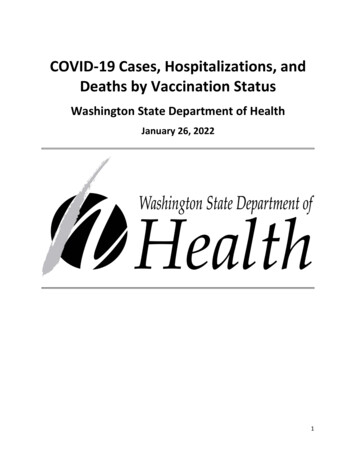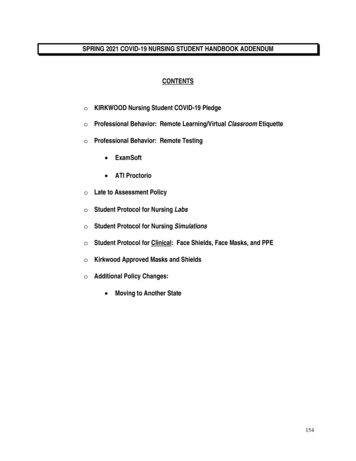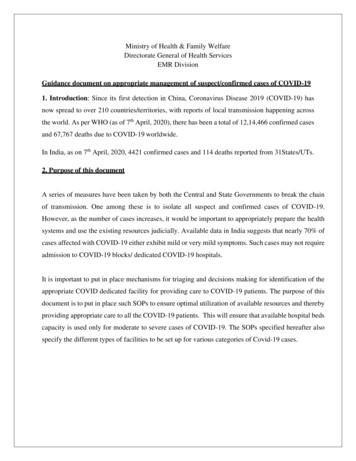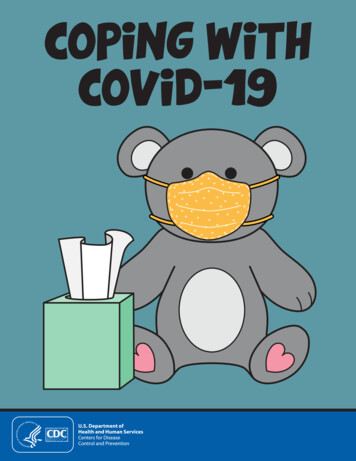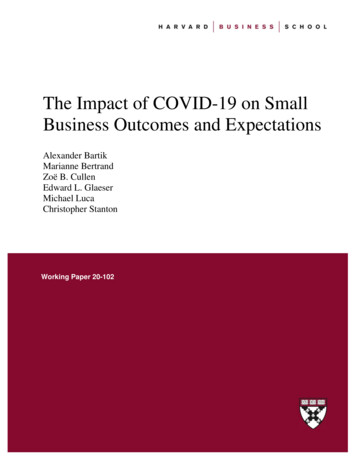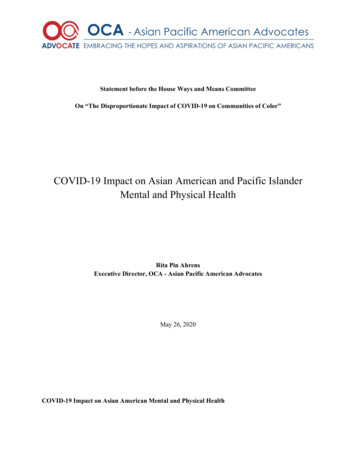
Transcription
Cliff GurenThad McIlroySteve SieckCOVID-19and BookPublishingImpacts andInsights for 2021
COVID-19 and Book Publishing:Impacts and Insights for 2021January 5, 2021Cliff Guren (Syntopical)Thad McIlroy (The Future of Publishing)Steven Sieck (SKS Advisors)
CONTENTSEXECUTIVE SUMMARY. 31. INTRODUCTION . 62. THE ECONOMY . 73. RETAIL . 144. HIGHER EDUCATION . 185. K-12 SCHOOLS . 226. ENTERTAINMENT INDUSTRIES. 267. LIBRARIES . 328. BOOKSTORES . 359. PUBLISHING . 3910. CONCLUSION . 46APPENDIX: TOPIC TRENDS IN BOOKS . 47ABOUT THE AUTHORS . 49COPYRIGHT . 50COVID-19 and Book Publishing — 2
EXECUTIVE SUMMARYBOOK PUBLISHING AND THE BIG PICTUREThe impact of COVID-19 on different industries, markets, and segments of society has varied widely.In broad terms, digital has benefited, while analog has struggled. Many of the larger companies havegained market share from their smaller competitors. The super-rich have massively increased theirwealth, while many of the poorest have suffered.Amid the upheaval, book publishers have, on the whole, fared well. The publishing industry,straddling as it does the poles of analog/digital, large/small, and for-profit/not-for-profit, has largelyescaped the COVID-inflicted disruptions faced by several other sectors.The most recent data from the Association of American Publishers (AAP), market researcher NPDGroup, and Publishers Weekly show solid gains through October across nearly all publishing sectors(K-12 instructional materials being the outlier), after a flat-to-declining performance in 2019. Supplychain issues have resolved themselves, and the shift of publishing staff to work-from-home has beenfairly seamless.Looking to 2021, most projections for the U.S. COVID-recovery economy as a whole are positive,with expected growth of 6% or more. Given that publishing sales have increased in the economicallychallenged environment of 2020, the prospects should be encouraging. Still, it remains to be seenwhether the reading-favorable environment of stay-at-home living has been just a short-term stimulantor represents a longer-term trend; and whether books can hold their share of consumers’ discretionarytime and budgets vs. the rapid growth of streaming media.THE OUTLOOK FOR RELATED SECTORSThe goal of this report is to look beyond publishing, to the surrounding sectors and to the largereconomic picture, in order to examine how changes outside of publishing could impact it.Retail. COVID-19 has driven a huge shift in the retail environment, from brick and mortar to online,and from the weaker to the stronger. At the end of the third quarter of 2020, the e-commerce share ofretail sales had increased by over a third from the previous year. Several well-established chains havefiled for bankruptcy, while Amazon, eBay, Walmart and Target reported record sales. Although booksthemselves have performed well, partly buoyed by the success of Amazon and of non-traditional bookretailers, year-to-date bookstore sales were down by almost a third through September.Libraries. The most contentious pre-COVID issue in the library market, a conflict over publishers’terms for ebook offerings, was superseded in the pandemic by an explosion of patron demand forebooks. But beyond the ultimate disposition of publisher conditions for library ebook sales, majorquestions remain for libraries post-vaccine(s). A lingering distaste for handling shared physical objectsCOVID-19 and Book Publishing — 3
and reluctance to spend time in public spaces may dampen demand for the return of more traditionallibrary services. And library budgets are likely to be early targets for the chopping block at the stateand local level.Education. The pandemic brought longstanding weaknesses in both K-12 and higher education to thefore, testing the value proposition of higher ed institutions and making stakeholders in K-12 moreaware of alternative approaches to classroom instruction. Publishers faced challenges in the form ofdeferred textbook orders and stressed institutional budgets. But years of investment in digital solutionsand a focus on flexible and inclusive subscription business models appear to be paying off in thehigher ed market, with strong growth in digital offerings that for some leading players has more thanoffset declines in printed textbook sales. And the K-12 market, as it emerges from the disruption oftraditional practices, also appears primed for growth in digital learning platforms.Entertainment Media. COVID-19’s impact on different segments of the entertainment sector hasvaried widely. The gaming and streaming video and music markets have seen big gains from homebound consumers, while the movie industry has been plagued by halted production and shutteredtheaters. The big winners appear to be those players with recurring revenue models who can bring awide choice of original programming directly into consumers’ homes. While competing forconsumers’ discretionary time and dollars, publishers will also be leveraging subsidiary rights fromexisting properties to feed the demand for that programming.OVERARCHING THEMESPrice-sensitivity. Consumer discretionary spending should rise with the economy’s anticipated growthin 2021, a positive note for consumer book sales. But there are clear signs of demand elasticity in, forexample, consumer willingness to add or cancel video streaming services to lower cost, and resistanceto paying high prices for home rental of first-run movies; and in the high demand for library ebooklending.Digital technology. The pandemic has accelerated the analog-to-digital evolution in every sense. WithSeptember ebook sales up 22% year over year and 16% year-to-date, publishers are revisiting theformat with new respect. The long-awaited payoff that educational publishers are seeing from theirdigital learning offerings, and the flow of venture investment to edtech innovations, are developmentsthat trade and other publishers would do well to observe.Direct-to-consumer marketing revisited. Publishers have been halting in their efforts to bypass theirtraditional B2B approach to book distribution. But the crisis in brick and mortar bookselling, growingdemand for ebooks, an emerging direct-to-parents channel for educational content, and thecompression of supply chains in an increasingly direct-to-home entertainment industry, all point to theneed to revisit D2C opportunities and strategies.Demand for video content development. The explosive growth of streaming video entertainmentrepresents a two-sided coin for publishers: a competitive venue for some successful authors, but alsoCOVID-19 and Book Publishing — 4
an opportunity for book rights holders to develop video properties and perhaps novel packagingstrategies for entertainment industry partners and other potential distribution channels.The social element. Enforced – or habituated – isolation should naturally result in heightened interestin alternative forms of social connection. The finding that 60% of gamers are playing moremultiplayer games, and specifically with social components, is one confirming indicator. Publisherswould do well to continue to develop community-oriented activities such as online book tours andsocial media initiatives like Penguin Random House’s “#BooksConnectUs.”COVID-19 and Book Publishing — 5
1. INTRODUCTIONThis report, a collective effort by three book publishing industry consultants, examines the impact ofCOVID-19 on sectors aligned with or adjacent to book publishing, in order to understand the broaderimpact that COVID may be having on the industry. We also seek to provide context via macro viewsof the economy overall and consumer spending more specifically. Our intention: to bring perspectiveto industry decision-makers regarding where we have been and where we are going in the COVID andpost-COVID era.Our methodology is based squarely on secondary research. We have combed through publiclyavailable literature produced during the pandemic, including articles, studies, blogs and otherresources, all of which are cited for further investigation by you, the reader. To this review of recentcoverage, we have added our own perspectives and takeaways regarding the implications for the bookpublishing industry, including trade, educational, and, to a lesser extent, academic.The report is thus a chronicle of the impact of, and responses to, the pandemic over the past year, and alook ahead. As we begin a new year, with the promise of a vaccine-enabled return to a new “normal,”many uncertainties remain. We hope that this review and analysis will help illuminate the way forwardin 2021 and beyond.COVID-19 and Book Publishing — 6
2. THE ECONOMYINTRODUCTIONCOVID is in control of the economy. Until the spread of the virus is halted or significantly diminishedfor a sustained period it will be impossible for anyone to offer a reliable economic forecast, short-termor longer-term.As of this writing, the party that will control the Senate in January has not been determined.Regardless of the victor, the Federal government’s ability to continue to respond to health andeconomic challenges remains uncertain, along with the public’s willingness to comply with themitigation measures already in place. The 900 billion relief package passed on December 21, 2020,the first encouraging sign in months, follows on the previous relief bill from back in April. As wefinalize this report there are strong indicators that the new administration intends to take decisiveaction on the economy early in 2021, but that remains speculative.While other chapters of this report drill down within specific sectors, here we will take a look at thebroader trends in the U.S. economy. In the section on Publishing we examine the largely positive 2020sales data within existing economic trends. In the section on Bookstores we review the significantdownward sales trend this year. The question to be addressed here is: in 2021, how will the broadereconomy impact both book publishing and retailing?THE IMPACT OF COVID-19 ON THE ECONOMY(i) Key U.S. dataGross Domestic Product (GDP) in the United States contracted roughly 2.4% in 2020. The FederalReserve projects 4.2% growth in 2021.1 The unemployment rate, which stood at 3.5% in January,2020, peaked at 14.7 % in April, then dropped to 6.7% by the end of November. New lockdowns intoat least January 2021 will likely increase the rate for the short term.2 The Conference Board ConsumerConfidence Index fell to 88.6 in December, down from November’s 92.9 (1985 100).3 Despite thebad economic news, U.S. stock markets hit historic highs in mid-December, with the Dow Jonesbreaking through 30,300, the Nasdaq Composite above 12,750, and the S&P 500 reaching 3,722.4(ii) The world dataAccording to the IMF, the world economy will contract by 4.4% this year, but grow by 5.2% in 2021(though that will still leave it only 0.6% larger than in 2019).5 The Poverty and Shared ProsperityReport 2020 indicates that COVID-19 is likely to push between 88 and 115 million people around theglobe into extreme poverty in 2020 (living on less than 1.90 a day).6COVID-19 and Book Publishing — 7
(iii) Consumer spendingData on trends in personal income and consumer spending turned negative in November: personalincome dropped by 1.1% and consumer spending by 0.4%.7The U.S. Bureau of Labor Statistics compiles a weekly Household Pulse Survey, measuring changes inconsumer spending behavior.8 The survey looks at four generations: Millennials, Gen X, BabyBoomers, and the Silent Generation. It considers the financial well-being of households within anincome range from 25,000 to 200,000 , and analyzes behavior changes occasioned by thepandemic.To the question, “In the last 7 days, how difficult has it been for your household to pay for usualhousehold expenses?” the results skewed toward youth: the younger the respondent, the greater thedifficulty. Of Millennials, 17.2% reported “very difficult” vs. 5.3% for the Silent Generation (seechart).Unsurprisingly, the income correlate was specific and direct: 32.7% of those with household incomesbelow 25,000 found paying very difficult, against 2.7% of those earning 200,000 or more.Behavioral changes are classified as “protective” or “relaxing” based on their adherence to pandemicavoidance behaviors. A “protective” behavioral change is one that conforms to pandemic-avoidancebehaviors (e.g., increasing online shopping, avoiding eating at restaurants), whereas a “relaxing”COVID-19 and Book Publishing — 8
behavioral change indicates a weaker adherence to pandemic-avoidance behaviors (e.g., increasing instore shopping, resuming eating at restaurants).There are few surprises here: the most often reported behavior changes are increased avoidance ofeating in restaurants (54.6%), more online purchases (48.5%), and increased use of credit card orsmartphone payment apps (34.8%). 20.4% increased their attendance at in-person medical or dentalappointments, while 28.7% cancelled or postponed them.Interestingly, the data again show that the younger the respondent, the greater the likelihood of takingadditional protective actions: 53.6% for Millennials overall, vs. 31% for the Silent Generation.Millennials (70.4%) were also most likely to make more purchases online, compared with 56.5% ofrespondents in the Silent Generation.COVID-19 and Book Publishing — 9
What are the takeaways here? Book purchasing and book reading skew heavily toward higherincomes. In one Bureau of Labor Statistics survey, the top 10% of earners spent nearly 8½ times moreon reading than the bottom 10%. And so while the pandemic is hitting lower earners financially moreheavily than the more prosperous, this is at worst a minor negative indicator for publishing’s bottomline.9Also, behaviors that were spotted early in the pandemic are, if anything, becoming more entrenched atthe end of 2020. The trend toward increased online spending, which we look at more closely in theretail section, continues for all generations.(iv) TravelThe pandemic’s brutal impact on travel and tourism is well known. The U.S. travel economy hasincurred over 500 billion in cumulative losses since March. Urban hotels are less than one-thirdfull.10 The leisure and hospitality industry accounted for more than one-third of all job losses in theU.S.11 55% of Americans said they would feel guilty traveling right now.12A major trend is a move toward domestic tourism—travelling closer to home. The relatively lowercost of domestic travel leaves discretionary dollars in consumers’ pockets. As we point out in theappendix on topic trends for book publishers, this is certain to be reflected in the travel book market, atleast in terms of the types of books purchased, and perhaps the quantity.13At a more fundamental level there is an expectation that business travel will simply not return to preCOVID levels. One estimate is that between 19% and 36% of business travel volume could disappearaltogether. Sales calls, as an example, may fully return to in-person meetings, because of thecompetitive nature of business, but internal company training sessions are more likely to remainvirtual. Because business fares contribute the majority of airline profits, this will force a radicalrestructuring in the airline industry, the effects of which are certain to be widely felt.14(v) Why the U.S. economy could take off in 2021 The Wall Street Journal strikes an optimistic note on the U.S. economy. “The story of 2021, however,will be of a great comeback.When it is safe for business to resume as usual, the economy could takeoff.” The factors identified are: New business applications have nearly doubled. Pandemic savings deposits of 2 trillion are waiting to be spent. People will continue to save time and money formerly spent on commuting.15A Bloomberg survey of Wall Street banks found growth forecasts for 2021 ranging from 5% to6.4%.16(vi) while growth remains negative in Q1JPMorgan, in its 2021 outlook, now says first-quarter growth will be negative, due to the stillspreading virus and associated restrictions, though they “expect the economy to expand briskly in thesecond and third quarter, based on positive vaccine developments.”17COVID-19 and Book Publishing — 10
(vii) A fundamentally changed economyU.S. Federal Reserve Chairman Jerome Powell described fundamental economic shifts accelerated bythe pandemic, including the increasing use of technology and of remote work. He said that whiletechnological advances are generally positive for society, in the short term they can create disruption,and the pain isn’t evenly shared. Lower-paid workers, often women and minorities, bear the brunt.18(viii) State budgets to take a hitTotal U.S. state budget shortfalls through 2022 could be “greater than the K-12 education budget forevery state combined in 2019.” Deficits have already prompted tax hikes and cuts to education,corrections services and parks. State workers are being laid off. Libraries fear cuts.While many states were in a better position pre-COVID than they were heading into the 2008 crisis,Moody’s Analytics projects that 46 states will be coming up short “even after rainy day funds areused.”19(ix) The rational stock marketWhat is wrong with this picture? The U.S. economy is facing its worst economic crisis in a dozenyears. Unemployment rates are high, and once again increasing. The central government is strugglingto implement a strong support program. Despite the prospect of a vaccine, the COVID-19 virus isclaiming more victims daily than in the initial outbreak last spring.And yet all three major U.S. stock market indices have hit new all-time highs in November andDecember 2020. This is not coming off a depressed pre-COVID market: the markets were boomingeven before the virus hit.Two concepts are frequently discussed to try to account for what could appear to be irrationalenthusiasm. The first is that relatively few industries, and companies within those industries, are propellingmarket growth: if it weren’t for Amazon, Apple, Tesla, Facebook, Google et al, the marketswould appear far calmer.20 The second is that, with historically low interest rates, cash and bonds are unattractiveinvestments when compared to a booming stock market. The 2 trillion in savings thatAmericans have accumulated this year “are looking for a comfy home.”15, 21None of the economic forecasts that we have reviewed in preparing this report consider the possibleimpact of a stock market correction on the broader economy. We will not venture a guess.CONCLUSIONEconomic forecasting is often characterized as a fool’s game. Fortunately, we report here only on thenotions of other fools, remaining a little above the fray. We can conclude definitively that there isuncertainty. Publishers in 2021 must continue to closely monitor macro-economic developments, notCOVID-19 and Book Publishing — 11
just in publishing, not just in retail, and not just in the U.S. broadly, but worldwide. Somewhere withinthat data are useful insights to inform your planning—if only for a month at a time.BIBLIOGRAPHY1. “Fed Raises Its Economic Outlook Slightly, Sees 4.2% Growth next Year and 5% UnemploymentRate.” Maggie Fitzgerald, CNBC, December 16, 2020.2. “Trading Economics: 20 Million Indicators From 196 Countries.” Tradingeconomics.com,Retrieved December 14, 2020.3. “During crucial holiday season, US consumer confidence slumps.” Matt Ott, Associated Press,December 21, 2020.4. “U.S. stock market clinches superfecta of record highs Thursday as bulls pin buying to fiscalspending bill.” Mark DeCambre, MarketWatch, December 17, 2020.5. “For the World Economy, a Grim Slog Tempered by New Hopes.” Peter S. Goodman, New YorkTimes, November 27, 2020.6. “The Impact of COVID-19 on Global Poverty under Worsening Growth and Inequality.” NishantYonzan, et al., World Bank Blogs, November 9, 2020.7. “Personal Income and Outlays, November 2020.” BEA, December 23, 2020.8. “Changes in consumer behaviors and financial well-being during the coronavirus pandemic:results from the U.S. Household Pulse Survey: Monthly Labor Review.” Thesia Garner et al., U.S.Bureau of Labor Statistics, December 17, 2020.9. “Consumer Expenditures in 2015: Report 1066.” U.S. Bureau of Labor Statistics, April, 2017.10. “COVID-19 Travel Industry Research.” U.S. Travel Association, Updated December, 2020.11. “Stats: Leisure & Hospitality Suffered 1/3 of All Job Losses Due to COVID-19.” Travel AgentCentral, August 12, 2020.12. “Update on American Travel in the Period of Coronavirus.” Destination Analysts, December 14,2020.13. “Why Airbnb’s IPO is a barometer for travel after the pandemic.” Dave Lee and Miles Kruppa,Financial Times, December 7, 2020.14. “The Covid Pandemic Could Cut Business Travel by 36%—Permanently.” Scott McCartney, WallStreet Journal, December 1, 2020.15. “Why the U.S. Economy Will Take Off in 2021.” Julia Pollak, Wall Street Journal, December 10,2020.16. “Wall Street Sees World Economy Surging in 2021 From Rocky Start.” Simon Kennedy,Bloomberg, December 11, 2020.17. “JPMorgan Becomes First Major Bank to Say First-Quarter GDP Will Decline Because of CovidSurge.” Patti Domm, CNBC, November 20, 2020.18. “The economy as we knew it might be over, Fed Chairman says.” Anneken Tappe, CNN,November 12, 2020.COVID-19 and Book Publishing — 12
19. “U.S. States Face Biggest Cash Crisis Since the Great Depression.” Heather Gillers, Banerji, WallStreet Journal, October 28, 2020.20. “This Bull Market Isn’t as Big as You Think.” Jason Zweig, Wall Street Journal, June 5, 2020.21. “Why the Market Is Booming and the Economy is Struggling.” Barbara Friedberg, U.S. News &World Report, September 15, 2020.COVID-19 and Book Publishing — 13
3. RETAILINTRODUCTIONPhysical retail and online retail have taken dramatically different paths during the pandemic. Wellestablished chains like Brooks Brothers, GNC, J. Crew, and Neiman Marcus have all made Chapter 11filings, while Amazon, eBay, Walmart, and Target reported record sales.And then there are product types, disinfecting wipes on one hand, and dress shirts on another—thepandemic has had drastically different effects on individual product categories. Books, though notofficially an “essential good,” have performed strongly through nearly a year of the pandemic. Butbookstores have not. As we question also in the separate section on bookstores, how might theyperform after the vaccine has been widely administered? Moving into 2021, what do the broadertrends in retailing suggest about bookselling in a post-COVID world?THE IMPACT OF COVID-19 ON RETAIL(i) The dataRetail sales are only slightly changed so far this year, measured against all sectors. But the broadpicture needs to be dissected. There have been huge swings month-to-month. April sales were down14.7% from March, but were followed by an 18.3% jump in May.1 November retail sales dropped1.1% from October, but were up 4.1% from November 2019.2 40 U.S. retailers have filed for Chapter11 since the pandemic started forcing shutdowns in March. More than 8,600 stores have closed thisyear.3Are things looking up? Certainly the arrival of the vaccine(s) has altered the mood. But the stillincreasing case rate cloud the picture. The holiday season normally accounts for roughly 20% of theretail industry’s annual sales.3 In the U.S. they rose 2.4% between November 1 and Christmas Evecompared with the same period last year. But most of those were online.4(ii) The continuing shift to online spendE-commerce represented 11.3% of retail sales at the end of 2019. In Q1 2020 it climbed modestly to11.8%. By the end of Q3 it stood at 13.5%, an increase of 36.7% from the third quarter of 2019. 5 AsAccenture noted, in a theme repeated elsewhere in this report, online retail “has seen 10 years ofgrowth in a matter of months.”6The big question is whether the increased shift to e-commerce will hold once the outbreak subsides.Moody’s retail analyst team is projecting online sales to “shoot above” 25% of all retail sales over thenext five years.7International research by consultants Oliver Wyman indicates that “up to a third of grocery customerswho began online shopping in response to the virus have a desire to continue shopping online evenafter the pandemic passes.” The research also suggests that consumer behavior in other industries,COVID-19 and Book Publishing — 14
including medical, household goods, and health and wellness, will follow suit, and become morepronounced the longer COVID-19-related restrictions stay in place.8(iii) The death of the mallThe mall sector has been under pressure for years because of the shift to online shopping and thefailure of some large anchor tenants (such as Sears). One estimate suggests that more than half of allmall-based department stores will close by the end of 2021, a severe blow given that department storesaccount for nearly one out of every three square feet in malls. As shopping malls lose their anchorstores, buyers have fewer reasons to visit.9A Moody’s report estimates that 20% of all mall stores could close in five years. Those closures “willhurt many weaker malls, which could in turn lead to their full closures or repurposing to alternativeuses (such as distribution centers).”7Relatively few independent booksellers are based in malls, but Barnes & Noble is heavily dependenton healthy malls for many of its 600 locations.(iv) Signs of a move to preserve local purchasingAmid the disruption in retail, there’s one positive sign for independent booksellers: an increasedappreciation of local businesses, imbued with the strength of their communities. According to anAccenture report, consumers are looking at “small, independent stores in their immediateneighborhood as much-loved places that they fear won’t survive. They’re making efforts to supportthese retailers and their staffs, ordering takeout and shopping there when they can.”10(v) Winners & losersDespite lockdowns, several brick-and-mortar sectors are thriving through the pandemic, notably homeimprovement stores (Home Depot, Lowes), mass merchandise retailers (Walmart, Target), warehouseclubs (Costco, BJ’s Wholesale Club), dollar stores (Dollar General, Dollar Tree), computer andelectronic stores (BestBuy), and pet care stores (Petco, Chewy).11Walmart sales were up 5.2% in the third quarter, year-on-year, to 135 billion. Home Depot sales wereup 23% in the same period. Macy’s meanwhile has seen sales drop by roughly a third this year.12(vi) Retail and mobileThe ever-increasing use of mobile devices for every part of the shopping process, from discoverythrough evaluation through purchase, has an impact on brick-and-mortar as well as online retail.Mobile sales accounted for nearly 75% of the 72 billion incremental e-commerce growth in 2019.Also, mobile sales, which were just 19% of digital sales in 2014, rose to 45% in 2019.13Even when shoppers seek to support local retailers and restaurants, they want to be able to interactonline, whether to check for product availability or to place an order. Many small businesses,including bookstores, have minimal e-commerce features on their websites, and will need to step uptheir game.COVID-19 and Book Publishing — 15
(vii) Trusting Amazon?We should mention here that Amazon is facing increased antitrust scrutiny in the U.S., and antitrustcharges in the European Union. The pace of progress in this sort of litigation is sufficiently slowmoving that it’s unlikely to impact Amazon’s overall sales in 2021, including book sales.14(viii) Best practices for retailersDistilled from several reports, here are a diverse set of recommendations around best practices inphysical retail, all of which may have applicability to bookstores. Safety and convenience are critical for the in-store experience. Consumers want stores tofollow guidelines that will keep both shoppers and employees safe. Organized and easy-to-navigate stores are even more appealing as many people seek to spendas little time as possible mingling with others in public spaces. Contactless purchasing: the ability to do self-checkout, and the ability to pay with asmartphone, is a priority for many shoppers. The next generation of loyalty programs will balance monetary rewards with “experiential”offerings designed to make consumers feel special and recognized (such as exclusive events,early access, unique discoveries), appealing both to the consumer’s head and to th
COVID-19 on sectors aligned with or adjacent to book publishing, in order to understand the broader impact that COVID may be having on the industry. We also seek to provide context via macro views of the economy overall and consumer spendi


